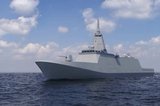CAES awarded $200 million contract to provide USN with large ship radar modules
Arleigh Burke-class Flight III ship USS Jack H Lucas is one of the USN's fleet fitted with AN/SPY-6 radars. (Photo: HII)
The contract is for follow-on, full-rate hardware production and sustainment and CAES will provide fully tested radar module assemblies for the USN’s AN/SPY-6 family of radars.
CAES has been a multi-year partner with Raytheon on the SPY-6 programme and has already begun delivering hardware.
According to CAES: ‘This follow-on, multi-year award demonstrates the continued, strong partnership between CAES and Raytheon, and our demonstrated capacity to provide the SPY-6 radar with reliable components and meet the USN fleet’s needs for many years to come.’
Related Articles
Raytheon progresses AN/SPY-6 efforts
SPY-6 can defend against ballistic missiles, cruise missiles, hostile aircraft and surface ships simultaneously and offers several advantages over legacy radars, such as greater detection range, increased sensitivity and more accurate discrimination.
Raytheon has developed four variants of the AN/SPY-6 using a scalable design, beginning with the AN/SPY-6(V)1 for Flight III Arleigh Burke-class destroyers. This radar features four array faces with 37 Radar Modular Assemblies (RMAs) apiece.
The second, AN/SPY-6(V)2 or EASR (rotor variant), designed for LPDs and the Nimitz-class aircraft carriers, features one rotating array face with nine RMAs.
AN/SPY-6(V)3 or EASR (fixed variant), designed for the Ford-class carriers and future Constellation-class frigate, comprises three fixed array faces, each with nine RMAs and offers air traffic control capabilities.
AN/SPY-6(V)4, designed to be retrofitted to the Flight IIA Arleigh Burke-class destroyers, features four array faces, each with 24 RMAs.
Related Equipment in Defence Insight
More from Naval Warfare
-
![US Navy advances with the Harpoon Service Life Extension Programme]()
US Navy advances with the Harpoon Service Life Extension Programme
The US Navy plans to improve Harpoon’s anti-ship and land attack capabilities by equipping the missiles with sensors and technologies required for succeeding in future battlespace.
-
![Mitsubishi eyes future with Australia’s Mogami selection]()
Mitsubishi eyes future with Australia’s Mogami selection
With Australia’s selection of the Mogami-class for Project Sea 3000, Mitsubishi is investigating local production in the next decade as potential export opportunities emerge.
-
![Hanwha wins Australian government approval to increase its stake in Austal]()
Hanwha wins Australian government approval to increase its stake in Austal
The contract would mean the two shipbuilders can collaborate strategically and enhance shipbuilding capabilities in Western Australia.
-
![Royal Australian Navy sizes up modernisation plans for new and existing capabilities]()
Royal Australian Navy sizes up modernisation plans for new and existing capabilities
The Australian navy is pushing ahead with its efforts to modernise its workforce and capabilities while balancing risky submarine upgrades, ageing Collins-class boats and a shrinking minehunter fleet. Head of navy capability RAdm Stephen Hughes updated Shephard on the force’s progress.























